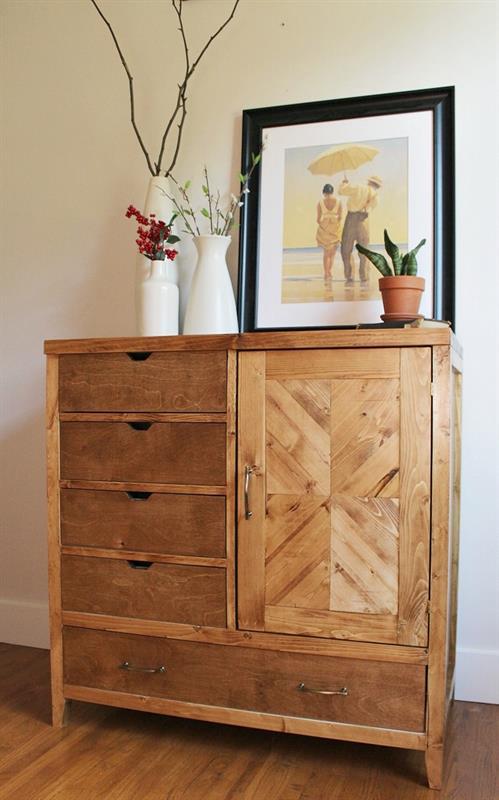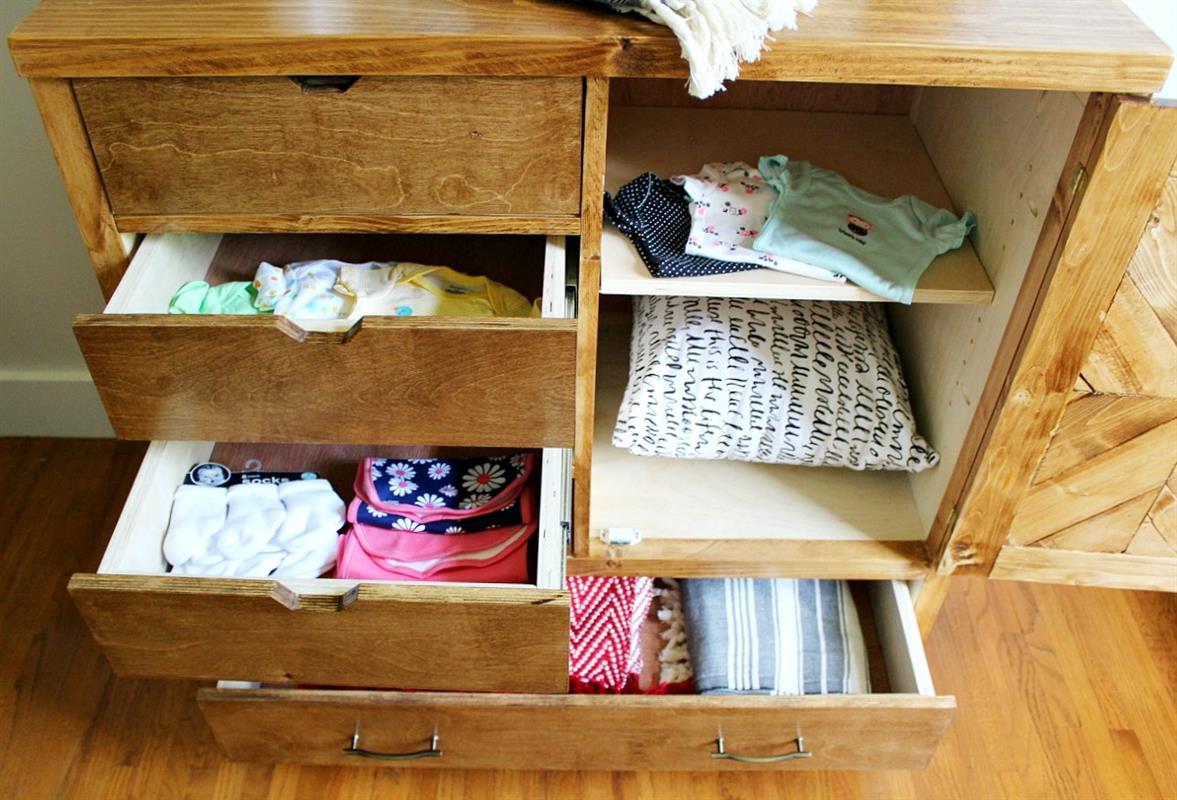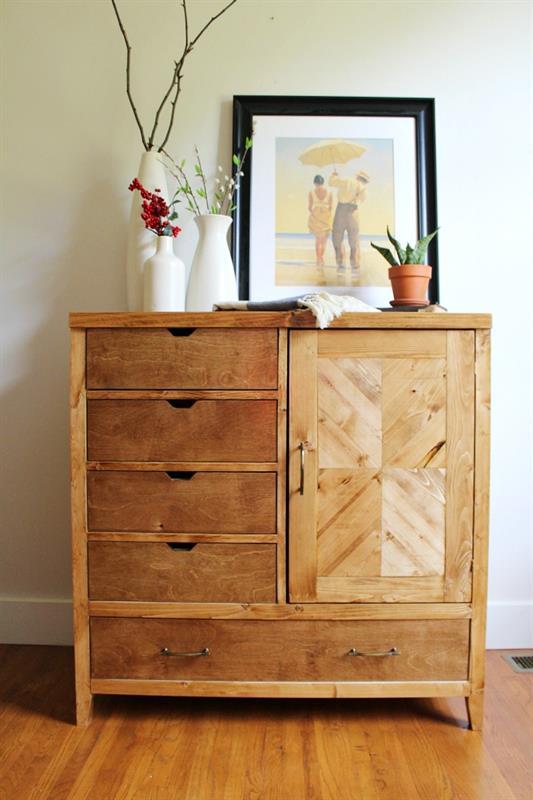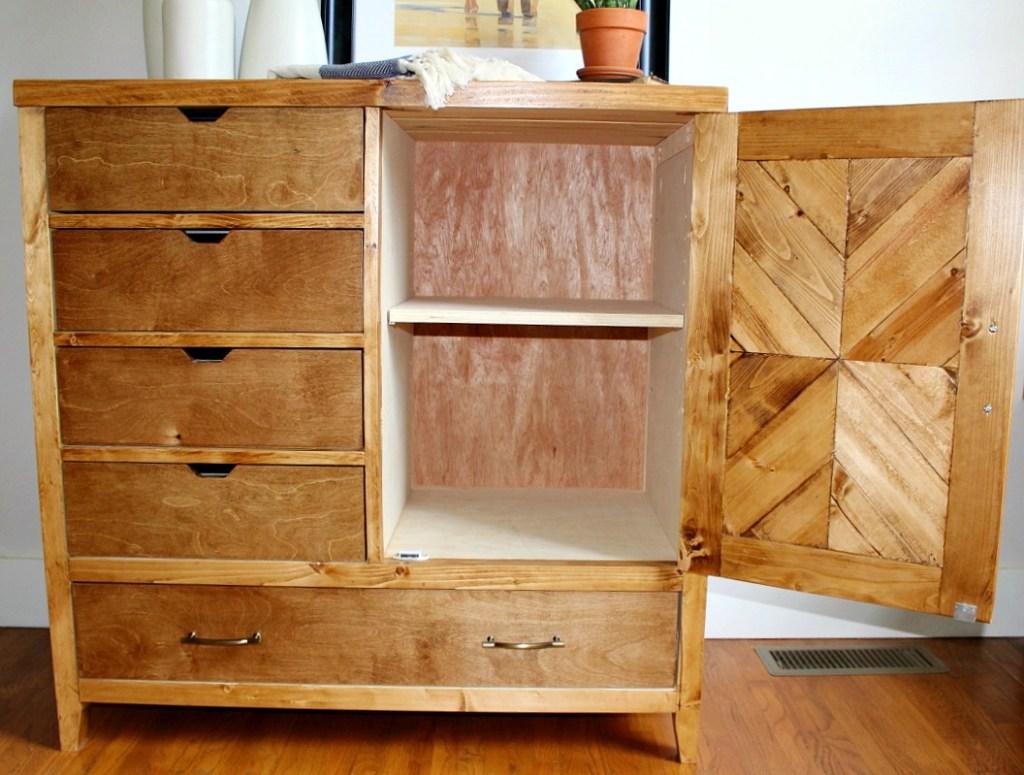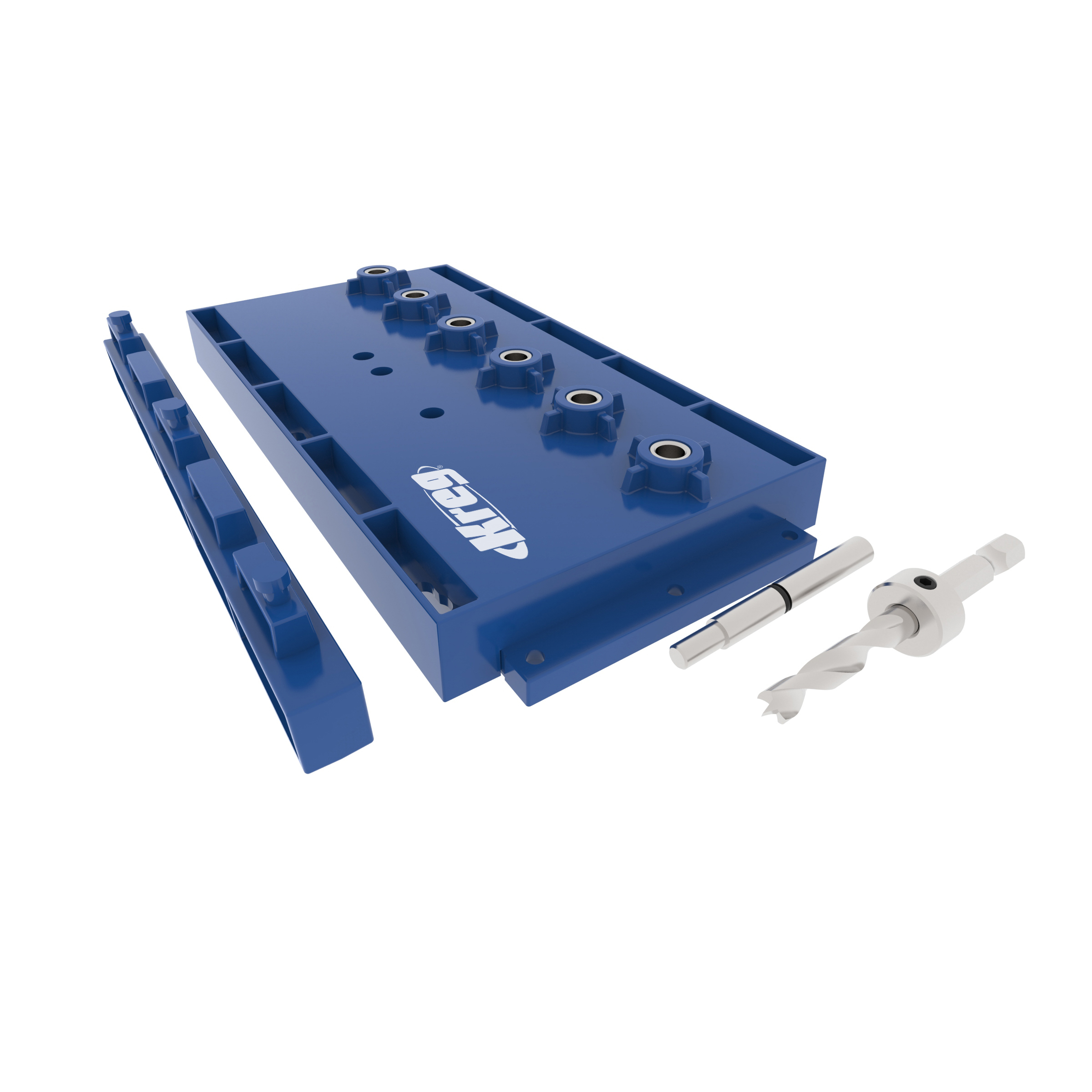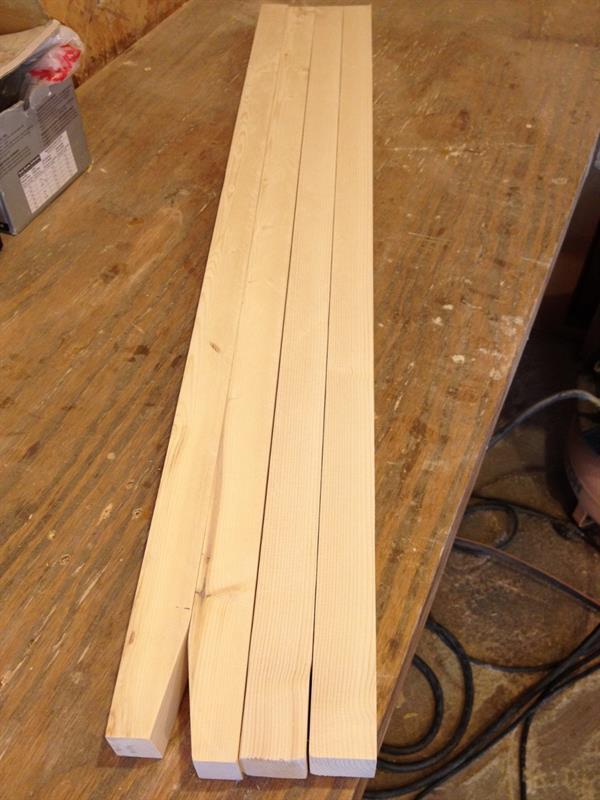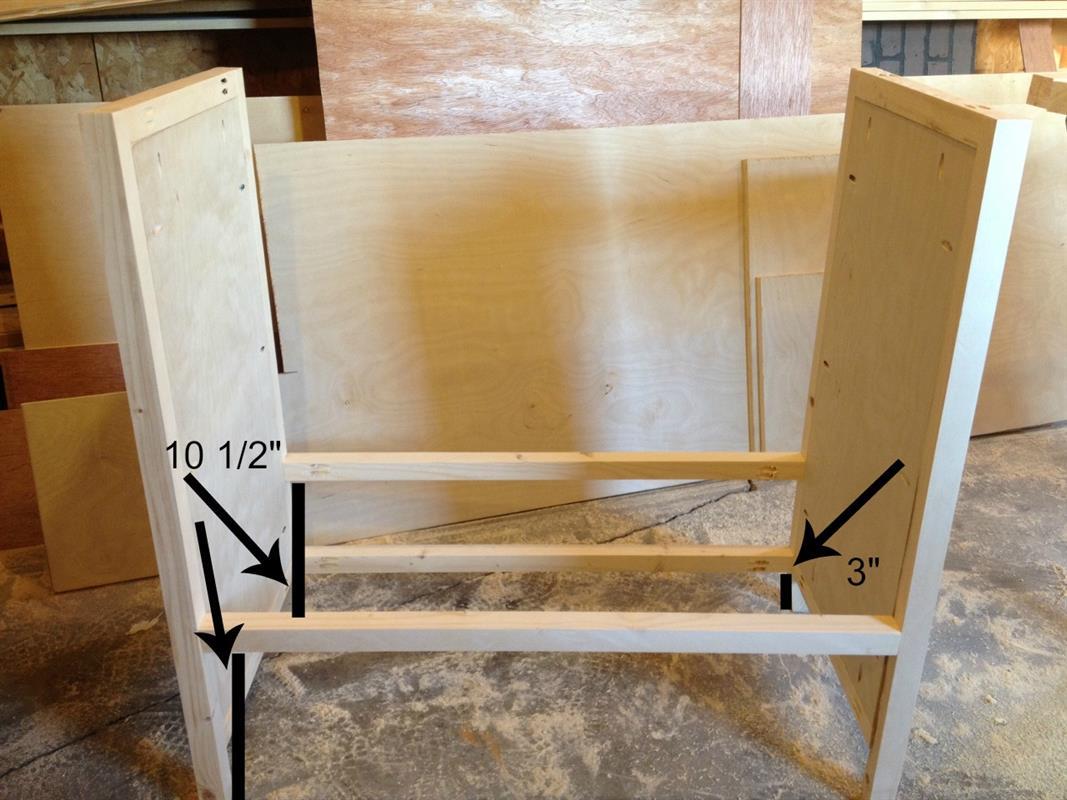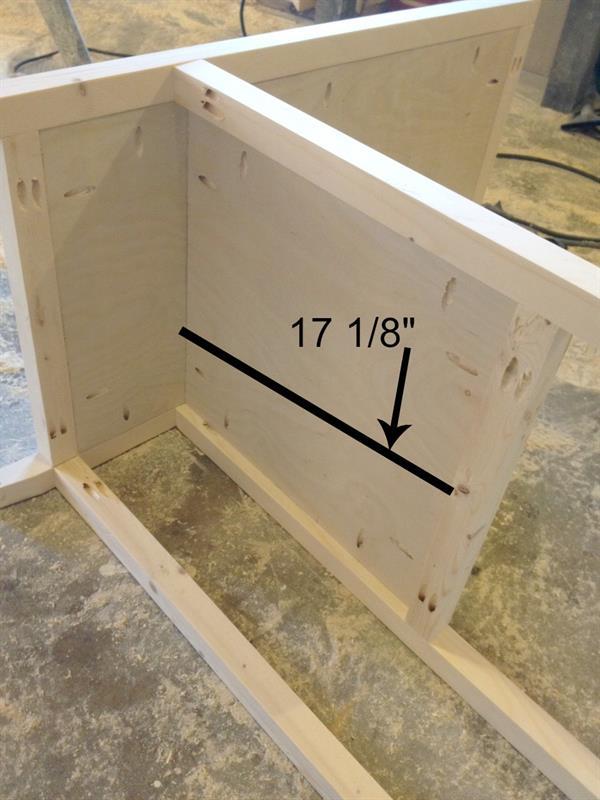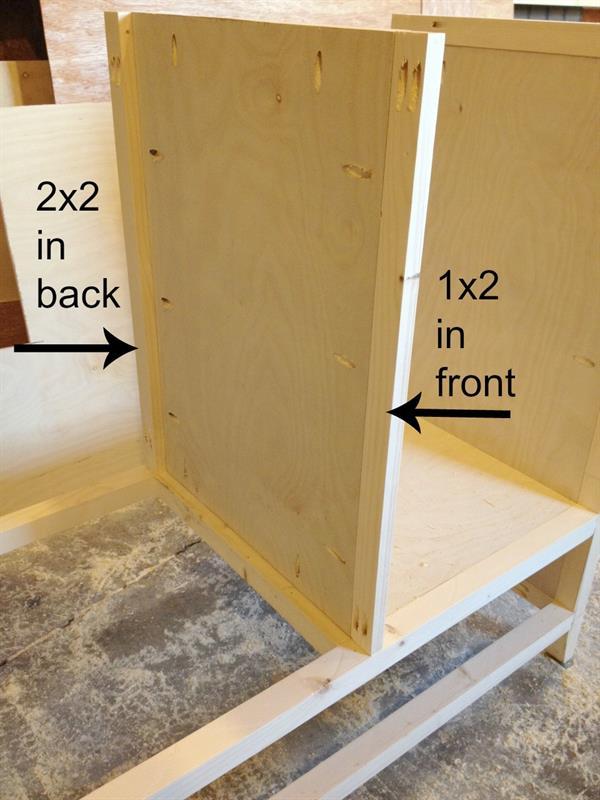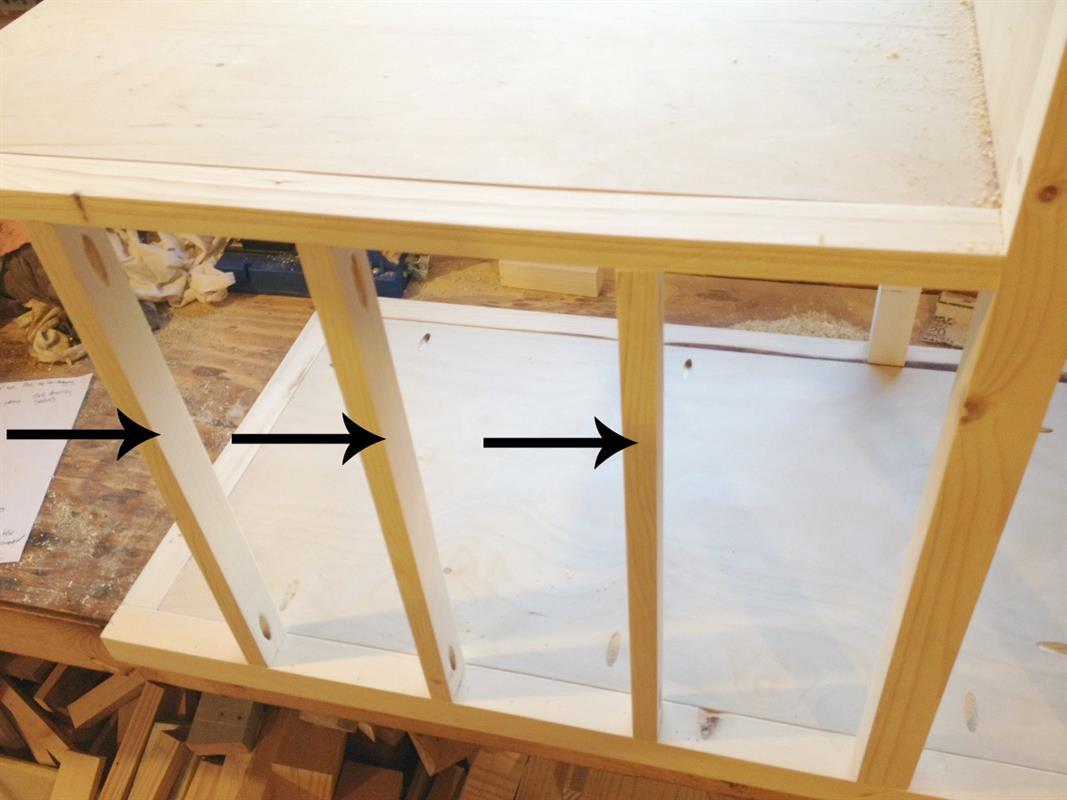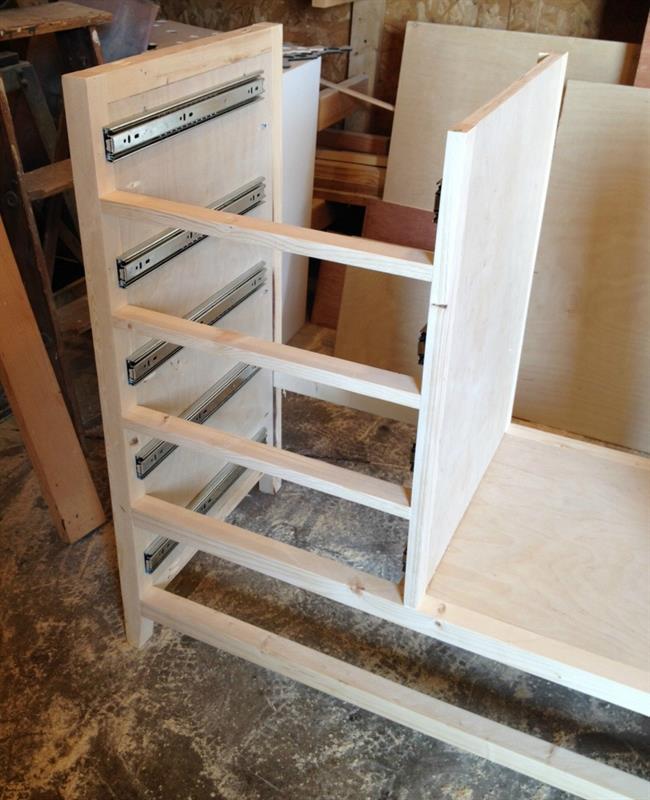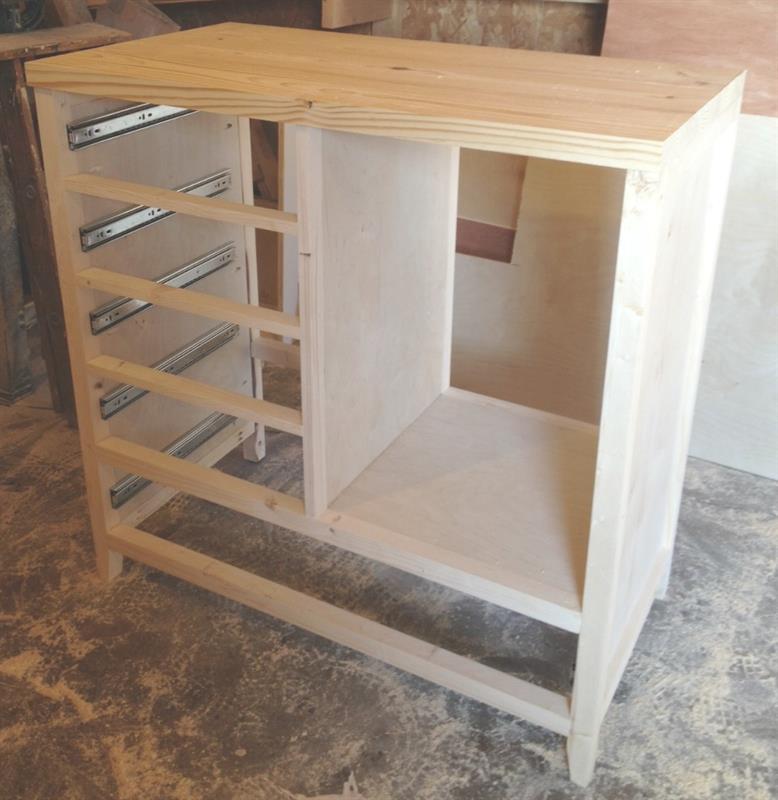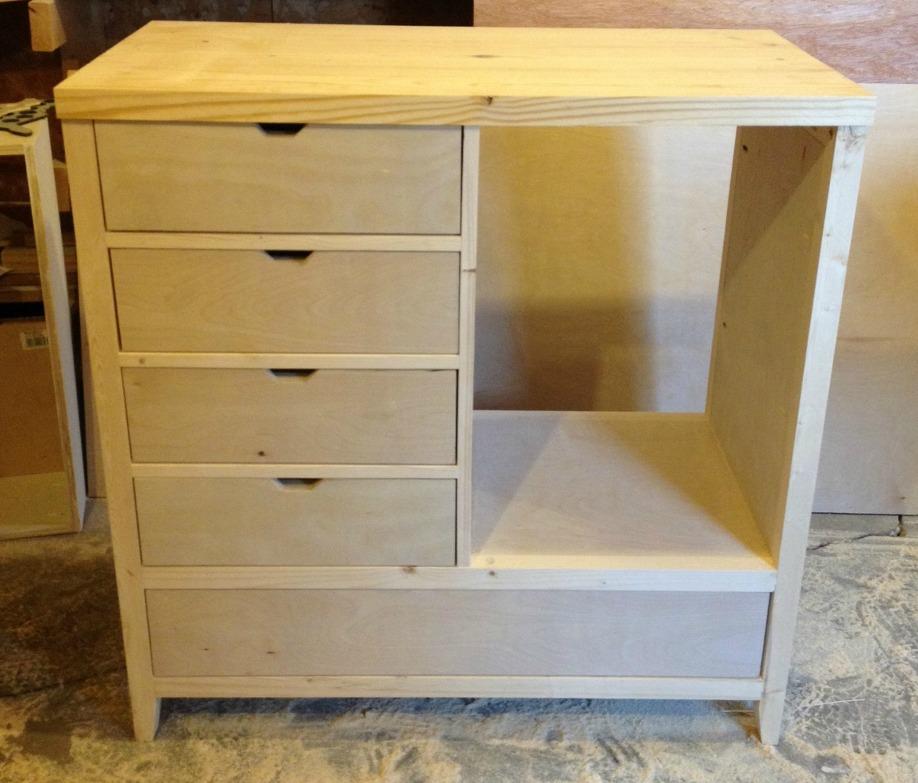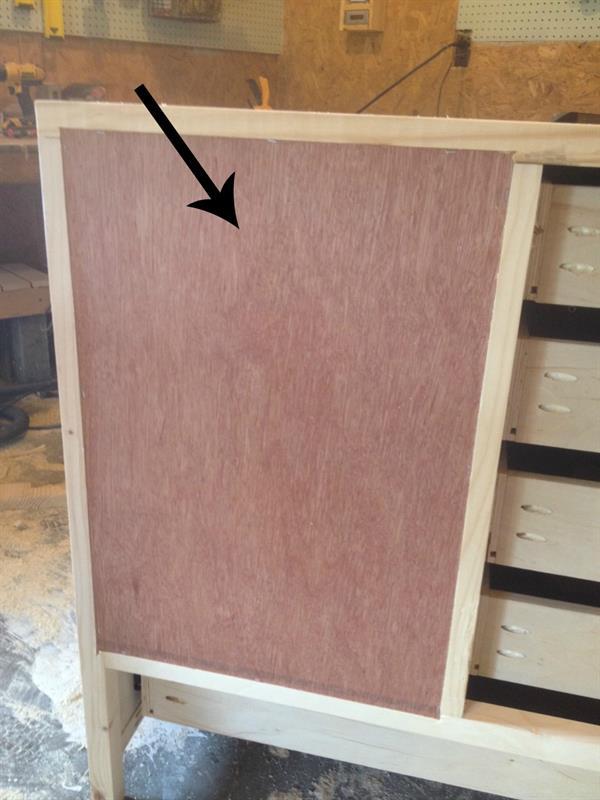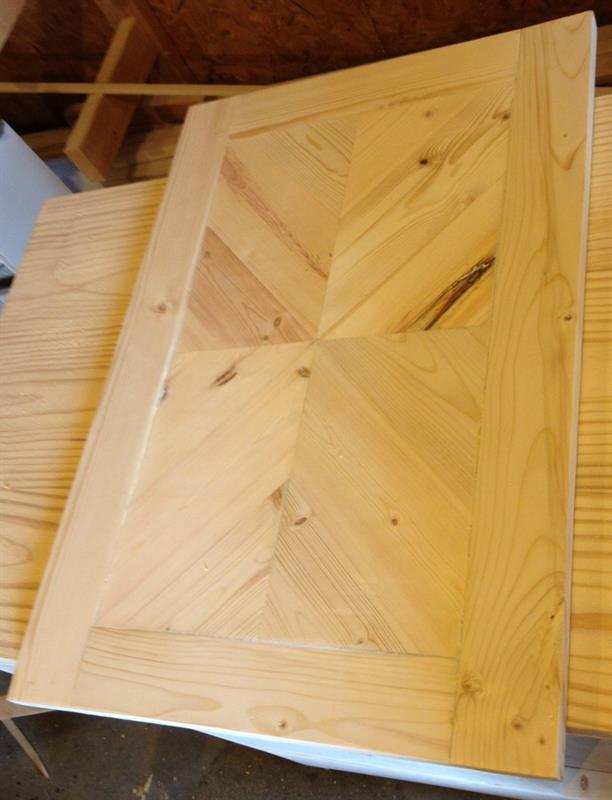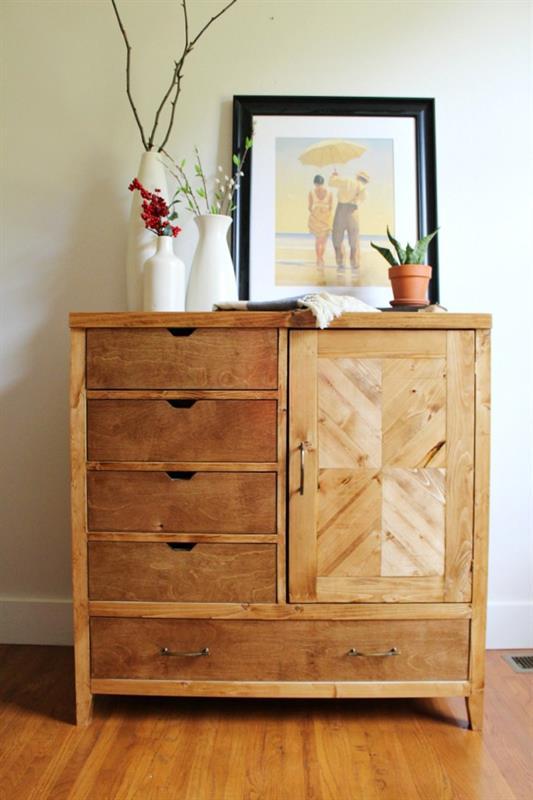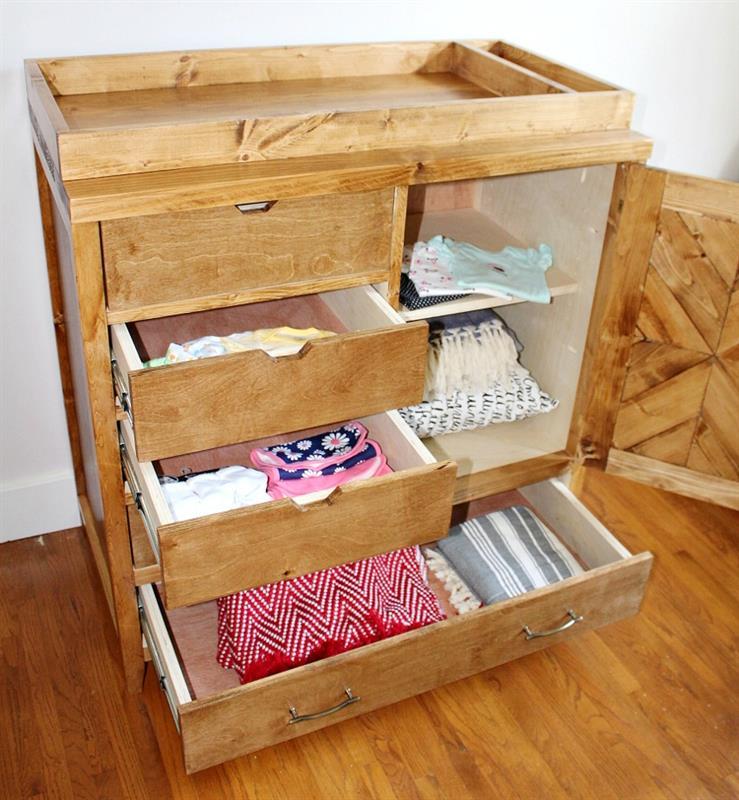5 Drawer Dresser with Door
By Woodshop DiariesThis dresser includes 4 drawers on one side, a storage cabinet on the other and a large drawer on the bottom for maximum storage potential. It's perfect as a regular bedroom dresser, or even as a changing table. The unique design is both modern and traditional and can fit any style.
Directions
-
Cut Legs
First, cut four 2x2s at 37” long for the legs of the dresser. Optional: you can taper the legs if you wish, but don’t taper above 3” from the bottom.
-
Build Side Panels
Rip 2 strips of ¾” plywood from the sheet at 17” wide. I used my circular saw and Kreg Rip Cut for this, but you could also use a table saw. From the strips, cut 2 pieces at 31” long. Save the remaining plywood for later steps. Drill ¾” pocket holes along the edges of the plywood panels. Cut 2 pieces of 2x2 at 17” long and drill 1 1/2 “ pocket holes in both ends. Attach these 2x2s, plywood panel and two legs together like shown to make 2 side panels. Use 2 ½” pocket holes screws with the 2x2s and 1 ¼” pocket hole screws with the plywood. Make sure the tapers are going the right direction if you tapered the legs.
-
Attach Side Panels
Cut 3 pieces of 2x2 at 35” long and drill 1 ½” pocket hole screws in both ends of each. Attach between the side panels like the picture shows. NOTE: the picture was taken from the back side view. Attach the bottom 2x2 on the front side 3” from the ground and the other two 2x2s (one in front, one in back) at 10 ½” from the bottom. Use 2 ½” pocket hole screws.
-
Attach Cabinet Bottom
Cut a 2x2 at 17” long and drill pocket holes in both ends. Attach using 2 ½” pocket hole screws between the two 2x2s from the previous step (that were added 10 ½” from the bottom) 17 1/8” from the right side if you are looking at the front. From the remaining plywood from step 2, cut a piece of ¾” plywood at 17” wide x 17 1/8” long and drill ¾” pocket holes along the edge. Place this panel in the opening like the picture shows and attach using 1 ¼” pocket hole screws so that it is flush with the 2x2s along the top.
-
Add Middle Divider
Cut one 2x2 and one 1x2 both at 25” long and drill pocket holes in each end (1 ½” pocket holes in the 2x2 and ¾” pocket holes in the 1x2). From the plywood strips cut in step 2, cut a piece of ¾” plywood at 17” wide x 25” long and drill pocket holes along the edges. Attach these three pieces together, then to the cabinet like the picture shows. Use 1 ¼” pocket hole screws to attach everything EXCEPT the 2x2 in the back. For that, use 2 ½” screws. Make sure this panel is attached 17 1/8” from the right side of the cabinet.
-
Attach Drawer Dividers
Cut 3 pieces of 1x2 at 17 1/8” long and drill one ¾” pocket hole in each end. Attach these along the front left side of the cabinet like the picture shows with 1 ¼” pocket hole screws. Make sure the spacing between them is even on both sides. It should be about 5 11/16”.
-
Attach Drawer Slides
Add 16” drawer slides to the cabinet for the four drawers on the left side and the large drawer opening in the bottom. Make sure to attach ¾” from the front to the drawer fronts can be inset.
-
Add Top
Build a top that is 38” long and 20 ¼” deep. You could use 1 ½” pocket holes and 2 ½” screws to attach the top boards, but I glued them instead. To make the top, attach (however you choose) 3 pieces of 2x10 boards slightly over 38” long together, then trim down to size using a circular saw or table saw. Once the top is cut, attach to the cabinet using the pocket holes already drilled along the middle divider. Along the inside of both side panels, “toenail” (drill in at an angle) through the 2x2s into the top with 2 ½” screws. Make sure everything is square when you attach it.
-
Make The Drawers
You’ll need to make 4 identical drawers for the left side and one wider drawer for the bottom. Rip strips from the remaining piece of ¾” plywood at 5” wide. Cut 10 drawer sides at 16” long and set these to the side. Then, cut 8 pieces at 14 5/8” long and 2 pieces at 32 ½” long and drill ¾” pocket holes in both ends of these 10 pieces. Attach the 14 5/8” long and the 32 ½” long pieces between two 16” long pieces using 1 ¼” pocket holes and screws to make 5 drawer boxes. Cut 4 pieces of ¼” plywood 16” x 16” and glue and nail/staple these onto the bottom of the small drawers. Cut another piece of ¼” plywood at 16” x 34” and do the same on the large drawer.
-
Install The Drawers
Now, simply install these drawers onto the slides you already installed in the cabinet.
-
Attach Drawer Fronts
Cut pieces of plywood to fit the drawer openings. Depending on how close your measurements are, these may vary slightly. It’s best to cut to fit, however, the small drawer fronts should be approx 16 7/8” long and 5 ½” tall and the large should be about 34 ¾” long and 5 ¾” tall. I notched out the middle of my small drawer instead of choosing to install pulls. This is optional. Once everything is cut to fit, screw the fronts on from the inside of the drawer using 1 ¼” screws.
-
Add Back
You could cut a piece of ¼” plywood slightly larger than the cabinet back opening and simply nail/staple onto the back. Or you could route out a groove so it will sit flush. Either way will work. I used a 3/8” rabbet bit on my router and cut a groove along the edge and cut a piece of ¼” plywood to fit in the opening. Whichever way you choose, staple the back onto the piece. You can cover the drawers if you want, but I chose to only put a back behind the cabinet part.
-
Add Shelf
I drilled shelf pin holes using my Kreg shelf pin jig in my cabinet so the shelf would be adjustable, but that is optional. You could use pocket holes and screws and attach a stationary shelf. Cut the shelf piece from the remaining ¾” plywood the size you prefer.
-
Add Door
Any door will do here, but I went with a “sunburst” door. There was a lot of trial and error with it, so be aware. I glued scrap pieces of 1x4 together with the ends cut at 45 degree angles to make 4 panels the same size (9 7/8” tall and 5 7/8” wide). Then I glued the 4 panels together, and trimmed my edges SLIGHTLY to get them flat and even. Then I glued 1x3s around the outside edge. Once all the glue was dry, I used putty to fill in any small gaps and sanded all the glue off. Once everything was finished, I attached using small brass butt hinges.
-
Finish
I stained the dresser using Minwax Early American and polyed it with Minwax Polycrylic. I added some brass drawer and door pulls and a magnetic catch for the door.
-
Additional Add On
This can be used as a regular dresser, but it will actually be used for a baby changing table as well. An optional add on is this changing tray. You could add this using 1x3s. Just glue and nail them together to fit the pillow you are using (pillow sizes vary), then screw in through the top from the underside.



